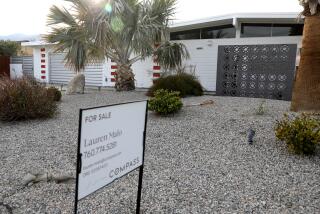Syndicators Facing Up to Some Changes
- Share via
One of the biggest factors fueling the commercial/investment real estate market in recent years has been the growth of real estate syndications and securities offerings.
Public partnership sales alone reached $7.4 billion last year, according to Robert A. Stanger’s Partnership Sponsorship Directory.
And unlike individual or institutional investors who may hold property for years, most real estate limited partnerships have specific holding periods (typically three to seven years) which guarantee a source of sellers and new buyers, creating other limited partnerships.
Enjoyed Booming Business
Real estate syndicators (those who organize investors--usually in the form of a limited partnership--for pooling capital to buy properties, have enjoyed a booming business for the last five years or so. Even in the real estate depression year 1981, $14 billion in public and private syndications were raised, according to the Real Estate Securities and Syndication Institute (RESSI).
During that time, groups of investors could purchase prime commercial properties unleveraged, thereby eliminating the need for 17% mortgages that most individual buyers faced at the time. Syndicators (and investors) also benefited from higher real estate appreciation and the extreme price concessions that sellers often gave.
Ironically, with today’s lower interest rates, many syndicators are again buying properties for cash. The reason? The risk that President Reagan’s proposed tax “reform” with its many unfavorable implications for investment real estate--such as limiting the amount of deductible interest and depreciation expenses--may finally be enacted. Realty limited partnerships will have to look attractive on their own, without the help of a tax shelter.
“We’ll be seeing some syndicators fail this year,” said David Fisher, president of the San Diego/Imperial counties chapter of RESSI and a real estate broker and attorney. “And I don’t foresee many new syndicators putting together deals in 1986,” he added.
Finance Big Syndicators
There are more than 100 real estate syndicators in San Diego County with about 50 RESSI members, according to Fisher. Most are putting together small deals, each under $5 million, which they often offer to employees, friends or references.
Aside from having a fair share of active real estate syndicators, Southern California’s passive investors are involved in financing the big public syndicators (such as Balcor, Integrated Resources and Consolidated Capital), which own property here and throughout the country.
What happens when billions of dollars become attracted to an investment vehicle? Some observers say that the syndication industry has driven up the prices of commercial real estate, and that the general partners can’t always find the best properties to buy.
While the rest of the real estate market is benefiting from the lowest interest rates in six years, syndicators face a number of new challenges, some arising from the low inflation. Several factors that will change the structure of real estate syndications in 1986 include:
Changes in Market
--Increased competition: both from among the thousands of syndicators and the bull stock and bond markets.
--Fear of tax changes detrimental to real estate: The concern now is that tax reform would take effect from Jan. 1, 1986 rather than having 1986 investors grandfathered in under existing tax laws.
--Negative publicity: As the syndication industry has matured over the last 10 years, some syndicators are coming under strain and their problems are being publicized.
--Questionable future appreciation: “At no other time can I remember such rent concessions given to office and industrial tenants,” Fisher said. “Furthermore, the predictions are for rents to decline over the next five years. In some cases, you can buy commercial property for less today than it was two years ago. Many people believe real estate prices have reached a ceiling.”
Emphasize Current Income
Fisher predicted that successful syndicators will be making some changes this year. Pacific Scene, one of San Diego’s largest residential builders, is considering several joint ventures for apartment complexes and other development in the $2-million to $3-million range through its Pacific Scene Financial, according to its president, David Charles.
More syndications will emphasize current income rather than capital gain or tax shelter. Realizing current income from rents will attract a different investor (for example, the retired) than those interested in tax loss.
“To maximize income, we buy our properties for all cash, so this puts us in a very good position for this year,” said Gerard DeLong, senior vice president for Realty Income Corp. of Escondido. The firm has been buying unleveraged properties for syndication since 1968. In 1980, it raised $5 million, and last year, it had sales of $78 million. This year, it is expecting to raise $100 million.
Distressed Properties
“I feel real estate will now be bought for its long-term performance. By owning the property free and clear, we maximize safety and income. We can’t undergo foreclosure (from a lender), and the tenants pay all operational costs, so our rent is pure profit,” DeLong explained.
Offerings of distressed properties (those performing poorly and which may be undervalued) for “vulture funds” are becoming popular among syndicators, since the buildings may have a stronger possibility for appreciation. In San Diego, Fisher said, the number of distressed properties is minimal compared to Houston, with its sluggish real estate market.
More to Read
Inside the business of entertainment
The Wide Shot brings you news, analysis and insights on everything from streaming wars to production — and what it all means for the future.
You may occasionally receive promotional content from the Los Angeles Times.








